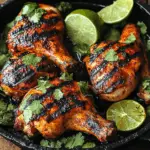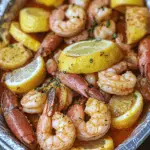The rich history and bold flavors of Cuba come to life in this iconic dish, Ropa Vieja. Literally translating to “old clothes,” this recipe is anything but tired, it’s a deeply comforting combination of slow-simmered beef, tomatoes, peppers, garlic, and spices that come together into a saucy, savory stew that’s both hearty and soulful.
Whether you’re looking for a cozy family meal, a culturally inspired dinner night, or simply want to explore the vibrant world of Latin cuisine, Ropa Vieja is a delicious gateway. Traditionally served with white rice, black beans, or tostones, it’s versatile enough to adapt to your tastes while staying true to its Cuban roots. Its tender texture and bold flavors make it an instant favorite for meat lovers and adventurous eaters alike.
Full Recipe:
Ingredients:
-
2½ to 3 lbs flank steak or chuck roast
-
1 tablespoon olive oil
-
1 large onion, sliced
-
1 green bell pepper, sliced
-
1 red bell pepper, sliced
-
4 garlic cloves, minced
-
1 (8-ounce) can tomato sauce
-
1 (14.5-ounce) can diced tomatoes
-
½ cup dry white wine (optional)
-
1 tablespoon tomato paste
-
1 teaspoon ground cumin
-
1 teaspoon dried oregano
-
2 bay leaves
-
Salt and pepper to taste
-
½ cup pimento-stuffed green olives, sliced
-
¼ cup chopped fresh parsley (optional, for garnish)
Directions:
-
Season beef with salt and pepper. In a large pot, heat olive oil over medium-high heat and brown the meat on both sides. Remove and set aside.
-
In the same pot, add onions and peppers. Cook until softened, about 5 minutes.
-
Stir in garlic and cook for another minute.
-
Add tomato sauce, diced tomatoes, tomato paste, wine (if using), cumin, oregano, bay leaves, and salt and pepper. Stir to combine.
-
Return the beef to the pot. Bring to a boil, then reduce heat to low. Cover and simmer for 2.5 to 3 hours, until the beef is tender and shreds easily.
-
Remove beef and shred using two forks. Return shredded beef to the pot and stir to coat in sauce.
-
Stir in olives and simmer uncovered for another 10–15 minutes.
-
Remove bay leaves, adjust seasoning, and garnish with fresh parsley if desired.
Prep Time: 15 minutes | Cooking Time: 3 hours | Total Time: 3 hours 15 minutes
Kcal: 365 kcal | Servings: 6 servings
Ropa Vieja: A Timeless Cuban Classic with Deep Roots and Flavorful Appeal
Ropa Vieja is more than just a hearty shredded beef dish, it’s a culinary expression of Cuban culture, storytelling, and tradition. This savory, tomato-based stew is one of the most beloved dishes in Cuba and has also gained popularity in Latin American kitchens and beyond. Its name, which means “old clothes” in Spanish, is thought to reference the dish’s appearance, tender strands of shredded beef resembling tattered rags, but don’t let the name fool you. This dish is anything but ragged when it comes to taste. It’s a richly spiced, deeply satisfying meal that offers layers of flavor in every bite.
In Cuba, Ropa Vieja is the national dish, and it’s easy to understand why. It uses accessible, simple ingredients, beef, tomatoes, bell peppers, onions, garlic, spices, and olives, yet yields a bold, vibrant, and comforting result. The secret lies in slow cooking. The beef is simmered for hours until it’s fork-tender and infused with the aromatic essence of cumin, oregano, bay leaves, and tomato. The briny addition of green olives adds a punch of brightness that balances the richness of the meat, while bell peppers bring a touch of sweetness and depth. When served over a bed of fluffy white rice with black beans or fried plantains on the side, it becomes a full sensory experience.
The History of Ropa Vieja
The roots of Ropa Vieja trace back to Spain, particularly the Canary Islands, from where it traveled to the Caribbean during colonial times. Originally a way to reuse leftovers, the dish evolved in Cuba to take on its own unique flavor profile, infused with African, Spanish, and Caribbean influences. In its earliest versions, Ropa Vieja was made from leftover meat stews. Over time, beef became the star of the show, slow-cooked until it reached that iconic shredded texture. Today, it’s a dish deeply connected to Cuban identity, prepared for family gatherings, holidays, and Sunday dinners alike.
Interestingly, Ropa Vieja carries cultural significance that transcends taste. It’s a dish that brings generations together. Many Cubans recall fond memories of grandmothers and parents preparing it slowly over the stove while the house filled with warm, savory aromas. Even outside of Cuba, for people in the Cuban diaspora, Ropa Vieja serves as a comforting reminder of home and heritage.
Key Ingredients and Flavor Profile
What makes Ropa Vieja stand out is how it transforms a humble cut of meat into something extraordinary. Typically, flank steak or chuck roast is used, both ideal for shredding after a long, slow braise. The cooking process allows the connective tissues to break down gently, rendering the meat ultra-tender and flavorful.
The flavor base starts with sofrito, sautéed onions, garlic, and peppers, a classic Latin American aromatic trio. The dish then builds with tomato sauce, diced tomatoes, and tomato paste to create a rich, savory body. Cumin and oregano add an earthy warmth, while bay leaves infuse a subtle herbal note. The addition of olives, and sometimes capers, adds a tangy contrast that elevates the whole dish. Some versions include a splash of dry white wine for depth, though it can easily be left out or substituted with broth.
Another beautiful aspect of Ropa Vieja is how flexible it is. Some cooks like to add carrots or peas, others finish with a splash of vinegar or fresh lime juice for brightness. While the traditional Cuban version keeps it simple and hearty, variations exist across Latin America, from Puerto Rico to Venezuela, each adding local flair.
Best Ways to Serve Ropa Vieja
Traditionally, Ropa Vieja is served over white rice, which soaks up the luscious tomato sauce. But the possibilities go far beyond:
-
With Congrí (Cuban Rice and Black Beans): A quintessential side that complements the robust beef perfectly.
-
Over Mashed Yuca or Plantains: For a starchy, slightly sweet contrast.
-
With Tostones or Fried Sweet Plantains (Maduros): For added texture and balance.
-
In a Sandwich or Tacos: Turn leftovers into handheld delights.
-
With a Side Salad: For a lighter meal.
No matter how you serve it, Ropa Vieja always satisfies. Its rich sauce begs to be mopped up with rice or bread, and its meaty depth makes it comforting yet refined.
Why You’ll Love This Dish
-
Hearty & Flavorful: Every bite is packed with layers of taste, from the savory beef to the tangy olives and sweet peppers.
-
Culturally Rich: You’re not just cooking dinner; you’re connecting with centuries of tradition and story.
-
Meal Prep Friendly: It reheats beautifully and even tastes better the next day as the flavors continue to meld.
-
Versatile: Serve it over rice, in tacos, or with whatever sides you love.
-
Freezer-Friendly: Make a big batch and freeze half for a no-fuss dinner later.
If you’re looking to expand your dinner routine and try something with heritage, soul, and unforgettable flavor, Ropa Vieja should be at the top of your list.
Cooking Tips for Perfect Ropa Vieja
-
Sear First: Browning the beef before simmering adds a rich depth to the overall flavor.
-
Low and Slow: Don’t rush the cooking. The long simmer is essential for tender, shreddable meat.
-
Don’t Skip the Olives: They provide a bright, briny balance to the richness of the dish.
-
Taste Before Serving: Before serving, taste and adjust the seasoning, a dash of vinegar, lime, or even sugar can bring everything together.
-
Let It Rest: Like most stews, Ropa Vieja is even better after resting. If you can make it a day ahead, go for it!
Conclusion
Ropa Vieja is more than a Cuban staple, it’s a timeless classic that showcases how simple ingredients, when treated with patience and care, can transform into a dish bursting with soul and history. From its Spanish roots to its Cuban reinvention, this shredded beef stew symbolizes resilience, warmth, and family traditions passed down through generations.
Whether you’re of Cuban heritage or just someone who loves trying dishes from around the world, making Ropa Vieja at home is a delicious way to experience a taste of Cuba. Its bold flavors, comforting texture, and cultural richness make it a meal that will easily earn a spot in your recipe rotation. Serve it up, share it with loved ones, and savor each bite, this is comfort food at its best.






